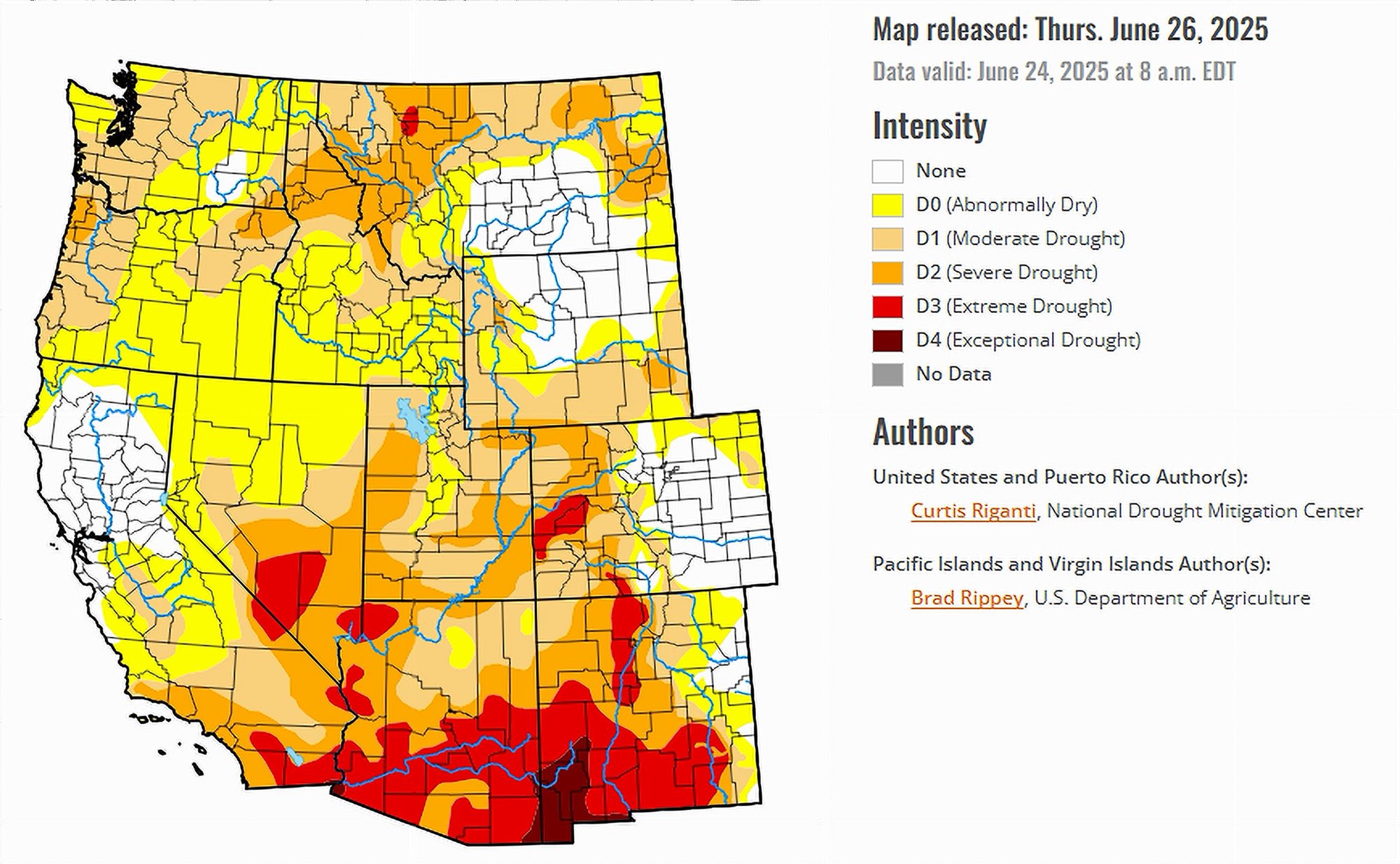- Moderate to severe drought is expanding in parts of Utah, Nevada, and Wyoming.
- Eastern New Mexico and southeast Wyoming have seen minor improvements following recent rains.
- Northern Colorado is showing signs of increased dryness, with reduced soil moisture.
- Monsoonal moisture may bring some relief to Arizona, New Mexico, and Utah in early July.
Saturday, June 28, 2025 — As of the U.S. Drought Monitor report released on June 26, 2025 , drought conditions across the western United States remain in flux. While scattered rains brought some temporary relief to select regions, significant portions of the Colorado River Basin continue to experience worsening drought, especially in parts of Utah, Nevada, Colorado, and Wyoming.
, drought conditions across the western United States remain in flux. While scattered rains brought some temporary relief to select regions, significant portions of the Colorado River Basin continue to experience worsening drought, especially in parts of Utah, Nevada, Colorado, and Wyoming.
Arizona: Holding Steady Ahead of Monsoon Season.
Most of Arizona remained stable this week, with no major changes in drought classification. The cooler temperatures seen across much of the western United States helped slow the rate of moisture loss, but conditions remain primed for rapid drying without incoming monsoonal rains.
California: Northern Regions Show Slight Degradation.
California’s far northeastern corner was impacted by expanding moderate drought, while the rest of the state remained relatively unchanged. Short-term precipitation deficits, declining streamflows, and soil moisture loss were identified as key stressors, particularly in high-elevation zones that rely on sustained snowmelt.
Colorado: Dryness Deepens in the North.
The situation in northern Colorado continues to worsen. “Short- and long-term precipitation deficits continued to grow,” the report noted , “which along with drops in soil moisture and streamflow led to localized worsening of drought or abnormal dryness.” These trends raise concern for agricultural interests and long-term water planning. Meanwhile, parts of southeastern Colorado may benefit from the early stages of monsoon season.
, “which along with drops in soil moisture and streamflow led to localized worsening of drought or abnormal dryness.” These trends raise concern for agricultural interests and long-term water planning. Meanwhile, parts of southeastern Colorado may benefit from the early stages of monsoon season.
Nevada: Drought Expands in the North.
Northern and eastern Nevada experienced an increase in both moderate and severe drought coverage. Although cooler weather prevailed, persistent short-term precipitation deficits and weakening vegetation health contributed to the decline. No significant improvements were reported, and soil conditions continued to deteriorate in parts of the state that feed into the Colorado River Basin.
New Mexico: Pockets of Improvement in the East.
Localized rainfall in New Mexico’s eastern plains led to minor improvements in drought designations this week. While the gains are limited, they offer a welcome reprieve amid longer-term dryness. The broader outlook remains cautiously optimistic, with the report stating that “monsoonal moisture streams into the region” are expected during the first week of July.
Utah: Northern Areas in Decline.
Utah saw some of the most notable setbacks in the basin this week. The Drought Monitor reported that “abnormal dryness and moderate and severe drought significantly grew in coverage in northern portions of Utah.” Short-term precipitation deficits and struggling vegetation were among the main factors. While southern Utah fared better, continued vigilance is needed as hot weather could return quickly.
Wyoming: Contrasting Trends Across the State.
Wyoming presented a split picture. The eastern and southeastern regions benefited from rains in recent weeks, improving soil moisture and easing drought conditions slightly. However, the western half of the state showed rapid drying, with expanding coverage of moderate and severe drought. “Poor vegetation health and locally decreasing streamflow and soil moisture” were cited in southwest Wyoming, while abnormal dryness grew near Yellowstone National Park.
Monsoon Season May Bring Relief.
The National Weather Service’s forecast for July 1–5 indicates a potential shift. The Climate Prediction Center “favors above-normal precipitation” across much of the Colorado River Basin. If realized, this could mark a turning point in a season marked by high variability and creeping dryness.


